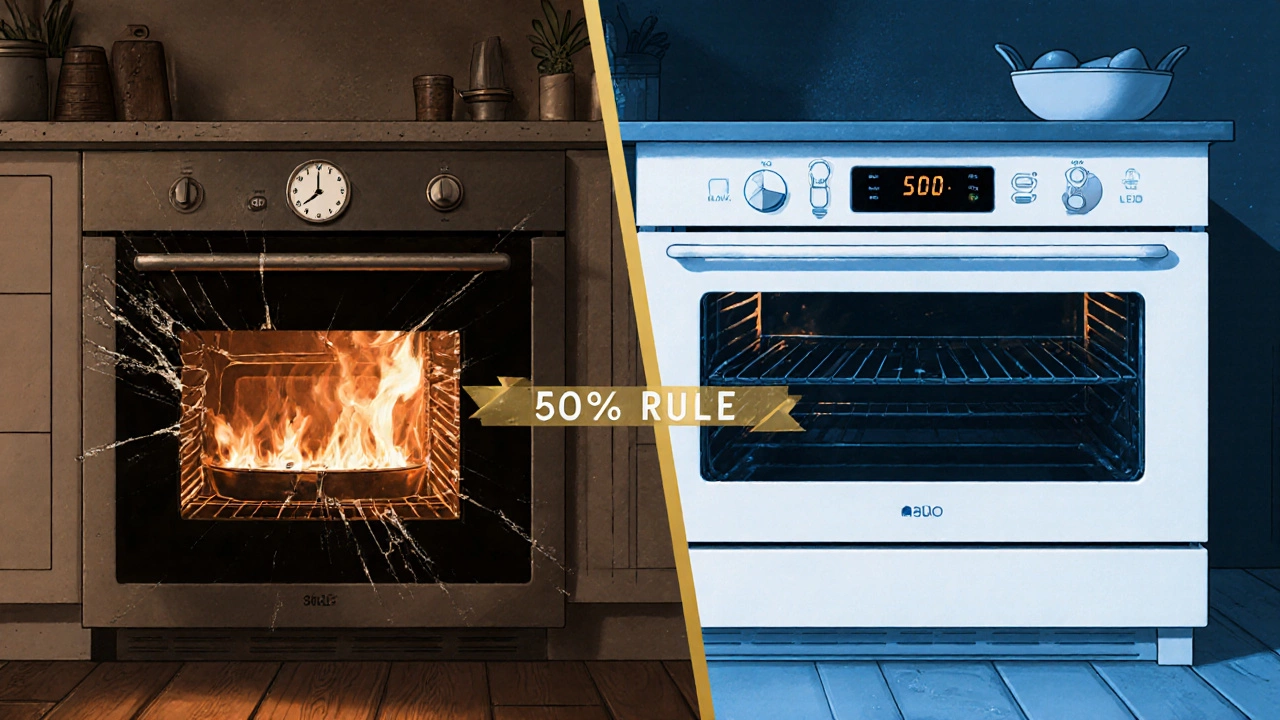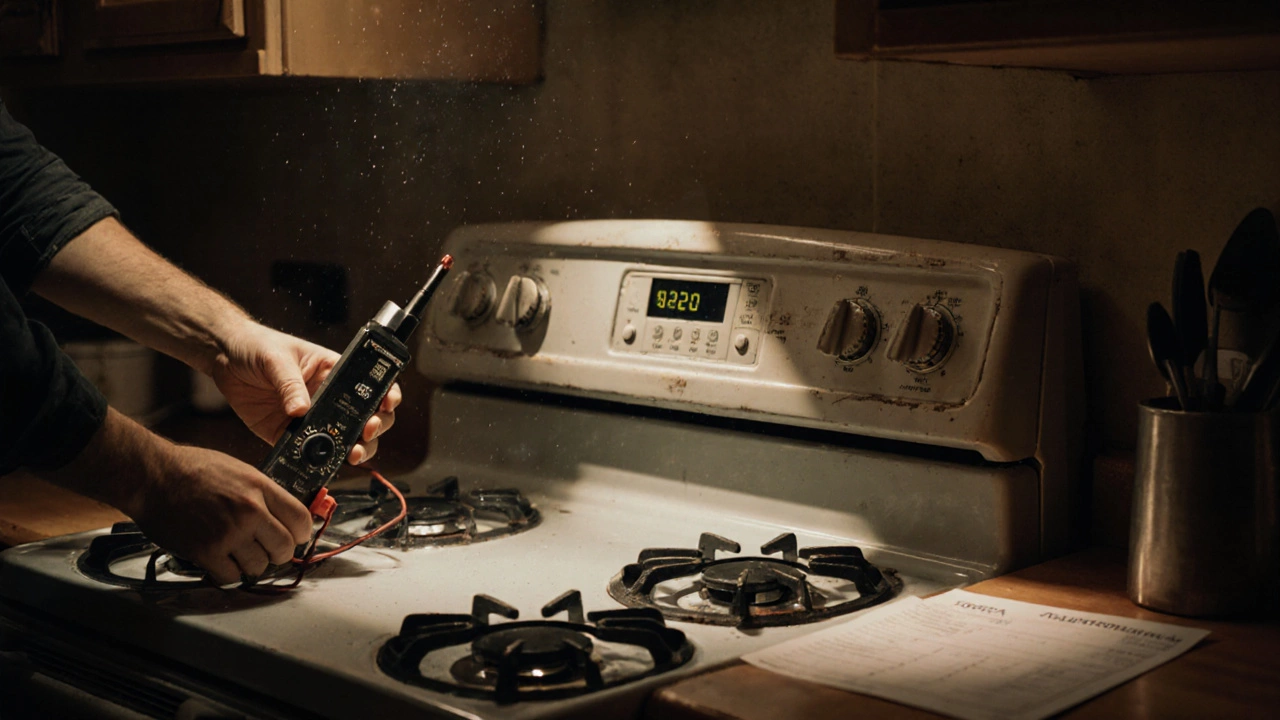Stove Repair vs Replacement Calculator
Your Current Situation
How to Use This Tool
Enter your specific numbers to see if repair or replacement makes more financial sense.
50% Rule: If repair costs more than 50% of a new oven, replacement is usually better.
Energy Savings: New ovens save $50-$100 annually on electricity bills.
Time Factor: Consider if you'll live in your home long enough to realize savings.
You turn on your stove and hear a strange click. The oven won’t heat. Or maybe the control panel is flickering. You look at the age sticker on the back - 10 years old. Now you’re stuck: spend $300 to fix it, or shell out $1,500 for a new one? It’s not just about money. It’s about time, hassle, and whether your old stove still has life left.
How long do electric stoves really last?
Most electric stoves are built to last between 10 and 15 years. That’s not a guess - it’s what manufacturers design for, and what repair technicians in Auckland see every day. Brands like Westinghouse, Smeg, and Bosch typically hit their 10-year mark with solid performance, assuming they weren’t abused. If yours is still heating evenly, the door seals aren’t cracked, and the elements aren’t glowing red in patches, it’s still in decent shape.
But here’s the catch: after 10 years, parts start to wear out faster. The thermostat drifts. The heating elements thin out. The control board gets temperamental. These aren’t sudden failures - they’re slow declines. You might notice it takes longer to preheat. Or the oven runs hotter on one side. That’s not normal wear. That’s the machine begging for help.
What’s the average repair cost?
Let’s get real. A technician in Auckland charges between $80 and $120 just to come out. Then you pay for parts. A new heating element? $40-$70. A control board? $150-$300. A faulty thermostat? $50-$90. If it’s a simple fix - like a broken igniter or a loose wire - you’re looking at $150-$250 total.
But if it’s the control board or a major component that’s failed, you’re flirting with $400-$600. And that’s before tax. At that point, you’re getting close to the price of a basic new electric oven. Some entry-level models start at $1,200, but mid-range ones with convection and smart features? That’s $1,800-$2,500. You don’t need to buy top-of-the-line, but you can’t ignore the fact that a $500 repair on a 10-year-old stove is a big gamble.
When repair makes sense
There are real cases where fixing it is the smart move.
- Your stove has unique features you can’t find in new models - like a built-in rotisserie, a specific oven size, or a dual-fuel setup.
- You’ve had it for 10 years and it’s never given you trouble until now. One part failed. That’s not a pattern.
- You’re planning to move in the next 1-2 years. A new stove doesn’t add value to your home, but a working one keeps your sale clean.
- You’re on a tight budget and can’t afford a replacement right now. Repair buys you time.
One Auckland homeowner I spoke to kept her 12-year-old Westinghouse oven going for another 3 years after replacing the control board. She paid $420 for the repair. She bought a new stove only when she moved into a bigger house. That’s a $1,260 savings over three years.

When it’s time to walk away
Some signs say: stop throwing money at it.
- The oven takes more than 30 minutes to reach 180°C - even after cleaning the elements.
- You’ve repaired it twice in the last 18 months. That’s not coincidence - that’s decline.
- The door doesn’t seal properly. You can feel heat leaking out. That wastes energy and makes cooking unpredictable.
- It’s using more electricity than it used to. Check your power bill from 5 years ago. If it’s 20-30% higher for the same cooking load, you’re paying for inefficiency.
- Parts are hard to find. If the technician says, “I’ll have to order this from overseas,” and it takes 3 weeks - that’s not service. That’s a warning.
Older stoves often use non-standard parts. New models are built with universal components. That means repair techs can fix most modern ovens in a day. For a 10-year-old unit? You might be waiting. And while you wait, you’re eating takeout or cooking on a hotplate.
What you’ll get with a new stove
Modern electric ovens aren’t just better - they’re smarter. Here’s what you’re missing out on:
- Energy efficiency: New models use 15-25% less power than ones from 2015. That adds up to $50-$100 a year on your bill.
- Even heating: Convection fans and better insulation mean no more undercooked chicken on one side.
- Smart features: Some ovens connect to your phone. You can preheat from work. Others have built-in recipes and auto-shutoff.
- Warranty: New ovens come with 1-2 years of coverage. Repairs? You get 3-6 months on parts.
- Resale value: A new kitchen appliance makes your home feel updated - even if it’s not a full renovation.
One family in Manukau replaced their 11-year-old oven with a 70cm Smeg convection model. They paid $1,900. Their electricity bill dropped by $75 a month. They got their money back in 20 months. And they haven’t had a single issue since.

The 50% rule - a simple decision tool
Here’s a trick most repair techs use: the 50% rule.
If the repair cost is more than half the price of a comparable new oven, walk away.
Let’s say a new basic electric oven costs $1,400. Half of that is $700. If your repair quote is $750? Don’t do it. Even if the stove works after, you’re risking another failure in 6-12 months. And the next repair? It’ll be even more expensive.
But if the repair is $500? And your stove is still reliable? Then it’s worth it. You’re buying another 2-3 years of use at a low cost.
What about secondhand stoves?
Some people consider buying a used oven from a secondhand store or online marketplace. It’s tempting - you can get a 5-year-old model for $400. But here’s the problem: you don’t know its history. Was it dropped? Overloaded? Run on faulty wiring? No warranty. No support. And if it breaks? You’re back to square one.
Unless you’re buying from a trusted appliance recycler that offers a 3-month guarantee, skip it. The savings aren’t worth the risk.
Final call: repair or replace?
Ask yourself these three questions:
- How much will the repair cost? If it’s under $500 and the stove’s been reliable, fix it.
- How much longer do you plan to live here? If you’re moving in a year, fix it. If you’re staying 5+ years, think about upgrading.
- Is your cooking life getting harder? If you’re avoiding baking because the oven’s slow, or you’re constantly adjusting temperatures - it’s time.
There’s no universal answer. But here’s what I’ve seen work: if your stove is 10 years old and needs a major repair, it’s not broken - it’s done. Not because it’s old. But because modern stoves do more, use less, and cost less to run.
That doesn’t mean you have to buy right now. But if you’re spending more than $500 to keep a 10-year-old oven alive, you’re not saving money. You’re delaying a smarter choice.
Is it cheaper to repair or replace a 10-year-old stove?
It depends. If the repair costs less than half the price of a new oven and the stove has been reliable, repair makes sense. If the repair is over $500 and the oven is struggling to heat evenly or uses too much power, replacement is usually cheaper in the long run.
How long should an electric oven last?
Most electric ovens last between 10 and 15 years. After 10 years, parts start to wear out faster, and repairs become more frequent and expensive. If your oven is still heating properly and hasn’t had multiple repairs, it can last longer - but don’t expect 20 years without issues.
Can I fix my oven myself?
Simple fixes like replacing a heating element or cleaning the oven sensor are doable for handy homeowners. But anything involving the control board, wiring, or gas lines should be left to a licensed technician. Mistakes can cause fires, electric shocks, or void your warranty.
Do new ovens save money on electricity?
Yes. New electric ovens are 15-25% more energy-efficient than models from 10 years ago. A modern oven with convection and better insulation can cut your cooking-related electricity use by $50-$100 per year. Over 5 years, that’s $250-$500 in savings.
Should I buy a secondhand stove to save money?
Only if it comes with a warranty from a reputable recycler. Most used stoves have hidden damage, no service history, and no support. You might save $400 upfront, but if it breaks in 3 months, you’re back to square one - and out the cost of a new repair.


